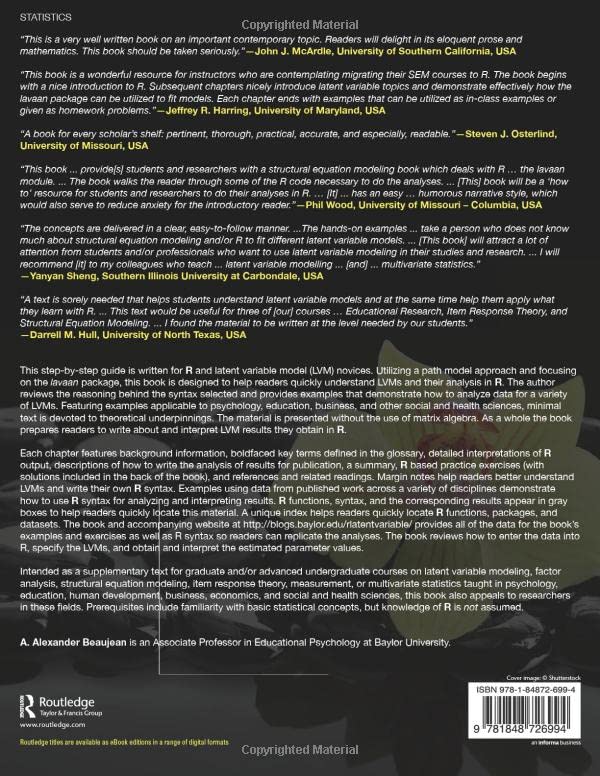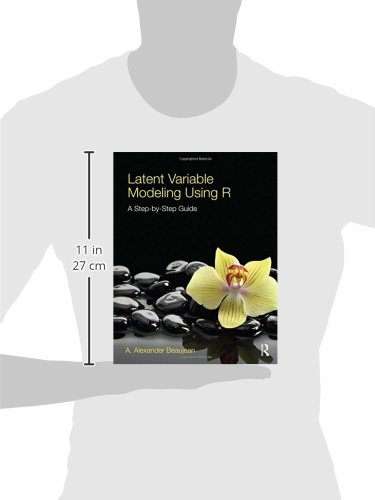



Full description not available
J**K
It would be a great textbook selection for a graduate-level introductory SEM class
In my opinion, as a comprehensive beginner's guide to SEM in R, this book is without peer. It would be a great textbook selection for n graduate-level introductory SEM class, as it covers the gamut of 'essential' SEM topics, such as model identification, scale setting, indexes of model fit, basic measurement and structural models, missing data, multiple groups (focused on invariance testing), longitudinal models, power, and categorical indicators. In fact, it's so affordable, that you could probably use it as an R-specific supplement to a book that provides a more thorough and conceptual introduction, such as Brown (2006), Kline (2010), or Hoyle (2012).For those who are already well-versed in SEM and lavaan, you probably already know much of what is in this book, although there are very useful tidbits here and there (e.g., how to manually free a specific parameter estimate).I only have two minor complaints:1) I'm not crazy about the order of the chapters. The chapters on missing data (Chapter 7) and power (Chapter 8), for example, are two of the last three of the chapters, when it is likely the case that these are more foundational topics compared to some of the advanced topics presented earlier in the book (e.g., multiple groups [Chapter 4], longitudinal models [Chapter 5], or categorical indicators [Chapter 6])2) Related to point 1), although some advanced topics--like multiple groups models--are introduced very effectively, I was less enthusiastic about the coverage of others. The chapter on longitudinal SEMs (Chapter 5), in particular, seemed much weaker than the other chapters in the book. For example, whereas group measurement invariance is covered extensively in the multiple groups chapter, the concept of longitudinal measurement invariance is not covered at all. Further, the chapter exclusively caters to the latent growth curve approach to longitudinal data analysis, and ignores other legitimate (and for a beginning, perhaps intuitive) longitudinal models, such as latent panel models. For these reasons, as mentioned in point 1), Beujean's book might be best used as a supplement to books covering specialized applications of SEM, such as Little's (2013) book on longitudinal SEM, when modeling needs are more complicated.These complaints aside, the book is a solid resource, with many good examples of code for lavaan and lavaan-affiliated packages (e.g., simsem, MICE, etc.,). If you're looking to learn or teach how to use SEM with freely available software (i.e., R), and want a book that covers most of the basics with examples of code that are relatively easy to follow, this is the book for you.PS: there is a typo in the effects-coding example on page 48. The actual code for effects-coding is correct ("a+b+c+d+e==5"), but the preceding comment ("# constrain the loadings to sum to one") is inaccurate: effects-coding constrains the loadings to AVERAGE to one (in this case, by summing to 5 across 5 indicators).
D**.
Great!
Great book!
B**T
This book is great for anyone interested in overcoming the learning curve for ...
This book is great for anyone interested in overcoming the learning curve for using R, and for anyone interested in Latent Variable Modeling and Latent Curve Modeling.
E**N
great companion to lavaan
Very useful companion to learning the latent variable technique hands on with good examples. R syntax unfortunately very small in the kindle version.
P**L
Absolutely incomprehensible
This is the single worst statistics-related book I have ever read. It reads more like a collection of facts about latent variable modeling than like a structured introduction. Some terms are only introduced after they have already been used in the text, some others are never explained at all. Important concepts such as the "tracing rules" are introduced as given, without any discussion of why they are the way they are. Do not expect to learn much from this book.
Trustpilot
2 months ago
1 month ago